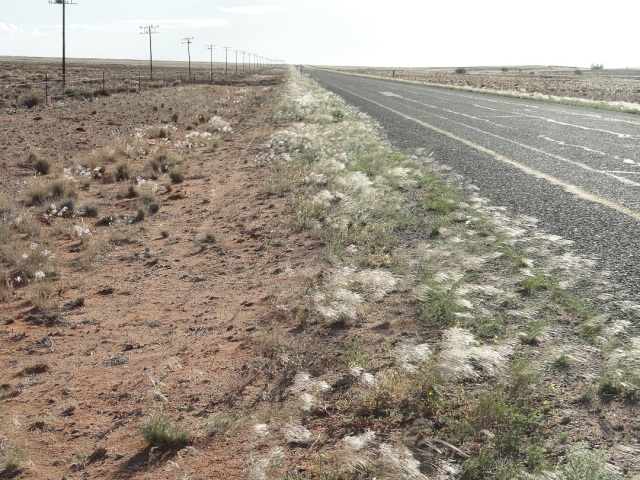
I took the above photo during my honeymoon, part of which included a drive from Springbok to Augrabies Falls in South Africa’s Northern Cape. I drove through this terrain for hours, and tried to imagine what it would have been like centuries ago, traveling in an ox-drawn wagon, with no road or power lines to follow. How did those first Afrikaners decide which direction to travel, and what did they think they would find on the other side of the nowhere? Occasionally I’d pass a lone farmhouse and wonder how self-sufficient the people there were. It was hours of driving to any source of supplies; what would they do if their vehicle broke down?
The most similar experience I had to this was probably when I drove across West Texas, although that was decades ago and I don’t remember it as vividly. To me, what is most striking about being in this type of flat, fairly featureless terrain, is that you realize not only are you in the middle of nowhere, but also that you could travel for hours (days if you’re on foot) in any direction, and you’d still be in the middle of nowhere.
I’ve been in other types of nowhere as well, such as a seemingly endless series of hills or sand dunes. This can be even more heartbreaking than looking out at miles of nothing; every hill or dune might be hiding your goal behind it (civilization, water to drink, the seven cities of gold) but as you reach the top, you see only another hill or dune in front of you. For the hundredth time. For the thousandth time… Imagine having a slightly OCD personality – you’ve already expended half of your water or other supplies and you know it’s time to turn back, but your goal could be right over that next hill…
The open ocean or outer space might seem like the ultimate nowhere, but unless the character in your story is just floating out there, the true setting is the ship or the lifeboat, rather than the nowhere itself. On the other hand, a character washed overboard from a ship or a downed airman bobbing in the ocean will have a lot of time for an introspective story. A 1970s Soviet Cosmonaut wouldn’t have much time to reflect on his life if separated from his space station, but spacesuits of the future might be able to provide more oxygen.
After you’ve decided what kind of nowhere to set your story in, you’ll next have to decide why your character(s) are there. A married couple on their honeymoon? Did they both think the trip was a good idea, or did the husband drag the reluctant wife along? Are the characters refugees from an invading army or a zombie apocalypse? Escaped convicts or army deserters on the run? Passengers of a crashed airplane or a broken-down bus? Or, like the previously-mentioned Afrikaners, did they set out looking for freedom and a better life, or did they just want to see what was out there?
You might want to have your characters argue about whether to go forward or turn back, or you might want to have one character caught stealing water or supplies from the group, but I instead enjoy this setting the most when the main character is alone on his journey, as the nowhere and the aloneness combine forces (of course this makes dialogue a bit difficult, unless your character likes to talk to himself). However, there is a character you might want to add if the protagonist intentionally set off on his journey: the Dog. Who would set off into the nowhere without their faithful canine companion? If your story takes place on another planet, the role of the Dog might be played by a robot, or by some semi-sentient or difficult to communicate with alien species.
Here’s a final idea that might work in a fantasy story, but doesn’t really apply to a modern-day or futuristic one: an invading army follows a road built into the middle of nowhere. They conveniently capture stockpiles of supplies and/or loot small farmhouses along the way, giving them just enough to keep going forward. After weeks of marching, they have become reliant on captured supplies, and don’t have the option of turning back. They come to the end of the road and see a monument built by the king whose lands they are invading. They read its inscription: “Thank you for feeding my vultures.”

I’d buy that for a dollar!
Reblogged this on Brainfluff and commented:
This term’s teaching focus is about writing mood music – so I couldn’t resist reading it when I saw this pic heading up Chris’s article. And when I read it, I couldn’t resist reblogging it…
The Karoo is a very desolate, beautiful place but I prefer the beaches of my country.
I love the beaches as well. I sometimes swim near Durban (usually at Umhlanga), where the water is partially netted, but I’m nervous about swimming at a net-free beach.
Wow, clever story idea!
This makes me think of the poem “Ozymandias” by Percy Shelley.
Yeah, that’s a great reference. For my idea I was thinking about a defensive measure in a kingdom that still existed, but it could certainly continue working after the kingdom was gone.
One of my brothers took a similar picture somwhere (nowhere?) in Arizona. There was a sign that said: “No parking anytime”!
🙂
That’s hilarious. For some reason, it reminds me of a section of highway that is full of potholes, and has warning signs about potholes. The road people came out, saw the potholes, and instead of fixing them, put up warning signs.
I grew up in an area of Nevada that’s much like you’re describing. I’m going to write a short story with some similarities to the isolation part sometime in 2017. Good post.